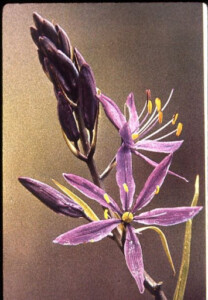Cooking Up Camas
(Camassia quamash)
The beautiful blue blooms you see in the fields and meadows in the Willamette Valley in early spring is the camas – – a staple in the diet of the Kalapuya Indians. A type of lily, the camas was (and still is) readily available in the wild. The bulbous root resembles the onion in shape and consistency but is considerably more bland in taste. Camas has also been called a wild hyacinth.
According to the journals of Merriwether Lewis, the Indians either ate the quamash “in its natural state, or boiled into a kind of soup, or made into a cake, which is then called pasheco. After the long abstinence, this was a sumptuous treat.”
Other sources say the Indians dried the root in a very specific procedure after harvesting. They started a fire at the bottom of a hole they had dug and let it die down to hot coals. Then they spread the coals over the bottom of the hole, covered them with dirt and leaves, placed the camas on top, added another layer of dirt and leaves, and built another fire on top of the whole thing. They cooked the camas for 24 to 48 hours to preserve it for consumption in the winter months.
The camas thus prepared was ground into meal in a large stone mortar with a pestle. To cook it, sometimes water was added to the ground meal to make a batter – – which was then fried on a large flat rock – – to make something similar to a pancake. Or, often the meal (and a small amount of water) was formed into large bricks weighing up to ten pounds, which were cooked in stone kilns that quickly seared the outside while leaving the inside moist for future use.
Harriet L. Smith, who wrote an Oregon vignette entitled Camas, the Plant that Caused Wars, says the name appears in Greek mythology, which tells of a plant started from the blood of a beautiful Spartan youth, Hyacinthus, whose death was caused by jealous Zephyrus. But, in the Willamette Valley, camas preserved and sustained life and brought beauty to Spring.
Written by Jordis Schick, compiled by Cynthia Harvey and Monica Mersinger
Bibliography:
Marion County HISTORY, Volume XV, Page 4. (Previously published May 1992, Vol. 30, No. 4)
This article originally appeared on the original Salem Online History site and has not been updated since 2006.








Leave A Comment